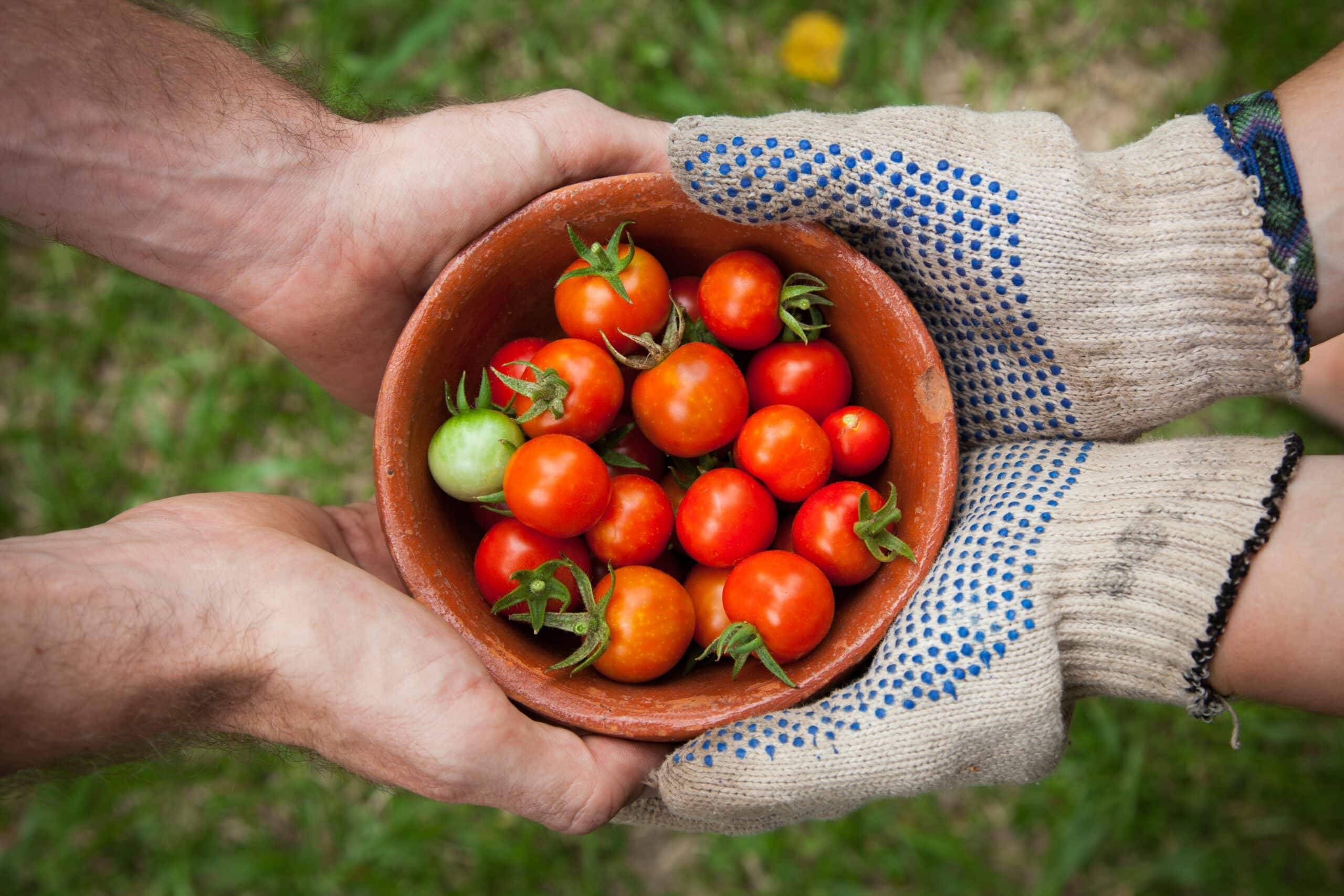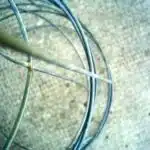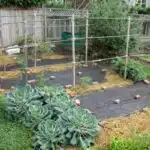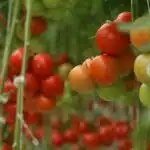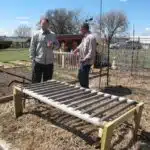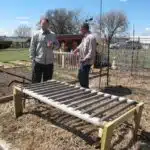Every summer, Bob and Betty spend hours tending to their vegetable garden in the backyard. This summer is no different, except for one thing: they decided to plant tomatoes. After some research, they determined that the best way to support their tomato plants was with stakes or cages. But which is better?
For gardeners looking for the best way to support tomato plants, there are a few options available. From traditional wooden stakes and cages to modern trellises and spiral supports, each has its own advantages and disadvantages. To maximize the health of your tomato plants and ensure a good harvest, you’ll need to choose carefully.
This article will explore four of the best ways to support your tomato plants – including their pros and cons – so you can make an informed decision about which one is right for you. Read on to learn how Bob and Betty were able to get a successful harvest from their tomato plants this year!
Selecting The Right Support System
Ah, tomato plants: the bane of every home gardener’s existence. Sure, they look great in your garden, but if you can’t keep them supported, it won’t be long before they topple over and become a mess. So let’s take a look at the first step to keeping them upright: selecting the right support system.
There are several types of support systems available to help keep your tomato plants from toppling over – from stakes and cages to trellises and string. It all depends on the type of tomatoes you’re growing and how much space you have available in your garden. If you’re growing indeterminate tomatoes (the ones that produce fruit all season long), cages are the best option as they provide strong, sturdy support without taking up too much space. Stakes are good for determinate tomatoes (the ones that produce fruit for a short period) as well as cherry tomatoes which tend to be relatively lightweight.
Cages also offer flexibility as they can be adjusted depending on how tall your plants grow, while stakes must remain in place once inserted into the ground. No matter what option you choose, make sure it’s strong enough to support the weight of your plants so they don’t fall over when filled with ripe fruit. Investing in quality materials is key here – after all, there’s nothing worse than having to replace or repair supports mid-season!
Investing In Tomato Cages
For those looking to take their tomato gardening game to the next level, investing in tomato cages is a great way to go! As an anachronism, it’s like putting your tomatoes in a high-end penthouse; they’ll be comfortable and look great.
Tomato cages come in many shapes and sizes, so you can find one that fits your plants perfectly. The cages are usually made of metal or plastic and will provide the necessary support for your tomatoes as they grow. They also help keep the plant upright and ensure that the tomatoes don’t become too heavy for the stems. Additionally, they provide a neat and organized look to your garden.
Installing stakes is another easy step toward ensuring your tomato plants have all the support they need. Stakes are typically used in conjunction with tomato cages or trellises and can help keep the plant from tipping over. This is especially important if you’re dealing with tall or heavy plants. Simply push them into the ground about six inches away from each other and tie some string around them for extra security if needed. With this simple setup, you’ll have healthy and well-supported tomato plants!
Installing Stakes
As the sun rises in the sky, casting its golden light on the garden bed below, a gardener can’t help but notice the thick stalks of their tomato plants. To ensure these fragile stems don’t buckle under their heavy load of ripe fruits, providing support for them is essential. One way to do so is through installing stakes.
Staking tomatoes involves inserting sturdy sticks into the ground beside each plant and gently tying or wrapping them up with string or twine. This provides support to the plant as it grows and helps protect the fruits from falling off. It also makes harvesting easier since all of the tomatoes will be in one place and easy to reach. Stakes are also helpful in keeping pests away from your plants because they can discourage animals from getting close enough to nibble on your fruits.
Not only do stakes provide a practical benefit, but they can also be aesthetically pleasing if done correctly. By choosing decorative poles that complement your plants’ colors and tying them up neatly with colorful twine, you can create an attractive feature in your garden that looks great while keeping your tomatoes safe and healthy.
Utilizing twine and string is just one way of supporting your tomato plants, helping you have a successful harvest season full of delicious fruits!
Utilizing Twine And String
As the old adage goes, ‘A stitch in time saves nine.’ This rings true when it comes to supporting your tomato plants. The fourth and final way to support your tomatoes is by utilizing twine and string. This type of support offers flexibility, allowing you to adjust the plant’s direction as it grows.
Twine and string can be used both horizontally and vertically for additional support. Horizontal strings should be strung between stakes or cages at least every 18 inches along the stem. Vertical strings should be secured at the base of each stake or cage, and then looped around the stem several times before being tied off. This helps to evenly spread the weight of the fruit, keeping them off the ground where they can rot or be attacked by bugs, fungi, or disease.
This method of support is also an excellent choice for determinate varieties because it allows you to move the plant in whatever direction you choose without having to remove stakes or cages. Additionally, if one side of a plant needs more attention than another due to environmental factors like wind or sun exposure, you can easily redirect it with twine and string. Understanding the benefits of pruning will also help you keep your tomato plants healthy and supported throughout their growing season.
Understanding The Benefits Of Pruning
Pruning is an important part of caring for tomato plants, as it can help the plant to grow strong and healthy. Pruning is done by removing the lower leaves or branches in order to create more air circulation and increase light exposure for the remaining leaves. This will also help to reduce disease and pests, as well as encouraging better yields from the plant. Additionally, pruning helps to improve the shape of the plant, making it easier to support with stakes or other supports.
The best time for pruning is when a tomato plant is young, as this will encourage it to develop a strong structure that can be easily supported later in its life cycle. It’s important to remember that pruning does not harm the plant; instead, it helps it thrive by encouraging new growth and boosting its overall health. When pruning, make sure not to take too much off at once – instead, just remove a few leaves or branches each time so as not to damage the plant.
Pruning your tomato plants correctly can have many benefits. Not only does it improve their form meaning they require less support when growing tall and heavy fruits, but also encourages healthier new growth and bigger yields. By understanding how pruning works you can ensure your tomatoes get all of these benefits while keeping them safe from disease and pests too!
Maximizing Air Circulation
When it comes to supporting tomato plants, air circulation can be a key step in keeping them healthy. Ensuring good airflow around the plants is essential for preventing disease and fungus growth, as well as helping the tomatoes ripen faster. It’s also important to consider how much space you have available in your garden or container – if there’s not enough room, the plant could become overcrowded and air circulation will be limited.
To maximize air circulation around your tomato plants, try training the stems on a trellis or stake. This will help keep the leaves off the ground and create more room for fresh air to circulate around them. If you’re growing multiple plants together, make sure they are spaced out properly so that each plant has its own space. Additionally, adding a fan nearby can help to improve airflow throughout your garden.
By ensuring good air circulation around your tomato plants, you can help prevent disease and promote healthy growth while also allowing them to ripen quicker. With proper pruning and adequate spacing between plants, you can create an environment that helps your tomatoes thrive.
Training Tomatoes To Your Support System
Training tomatoes to your support system is an important step in ensuring their success. This can be done by gently guiding the stems of the plants onto the supports as they grow. The goal is to keep the stem and leaves off the ground, while still allowing enough space for air circulation around them. During this process, it’s important to avoid cutting or breaking any of the branches.
It’s also a good idea to check regularly on your tomato plants to make sure that they are staying securely in place on the supports. If any of them appear to be slipping off, you should adjust them back into place as needed. Additionally, you may want to add additional ties or clips onto your supports if necessary in order to keep everything secure and upright.
By following these steps, you can ensure that your tomato plants get all the support they need throughout their growth cycle and produce a strong harvest at harvest time. The next step is keeping your support system secure so that it will stay intact for years to come.
Keeping Your Support System Secure
When it comes to tomato plants, the support system you choose can make a huge difference in their growth and health. Keeping that support system secure is essential for successful harvests. To do this, you’ll need to ensure your supports are firmly anchored into the ground. This will help them withstand windy days and heavy stem loads from larger fruits.
It’s also important to check your support structure regularly for any signs of damage or wear and tear. If any pieces have become loose or broken, replace them promptly before any further damage can occur. This will help prevent the plant from toppling over or having its fruit damaged by the ground.
Finally, it’s important to use strong materials like bamboo poles or metal stakes that are rust-resistant so they stay sturdy throughout the growing season. Make sure these supports are tall enough so they don’t get buried in soil as the plants grow taller with each passing day!
Recognizing Potential Problems
When it comes to successful tomato growth, recognizing potential problems is just as important as providing the right support system. Tomato plants need plenty of attention and care, and it’s essential to monitor them for signs of distress. Without proper monitoring and identification of issues, tomatoes won’t be able to reach their full potential.
Early recognition is key when it comes to addressing tomato plant problems. If left unchecked, a minor issue can quickly become a major problem that affects the entire plant. For example, spotting early signs of disease or pests can help you take preventive measures before the situation gets worse. It’s also important to check your tomatoes regularly for yellowing leaves or wilting stems that might signal an unhealthy plant.
In addition, taking the time to observe your tomato plants can help you learn how they respond to different conditions. This way, you’ll be able to recognize when something isn’t quite right and take steps towards fixing it before it becomes too late. By staying vigilant and being mindful of your plants’ needs, you’ll be better equipped to prevent any issues from arising in the first place. From there, avoiding overloading your support system will be much easier.
Avoiding Overloading Your Support System
Hold tight, because this last step is sure to be a game-changer! We’ve reached the final tip on supporting your tomato plants: avoiding overloading your support system. This incredibly important method is essential if you want your tomatoes to reach their fullest potential.
When it comes to setting up a support system for your tomato plants, there’s one key rule that you need to remember: less is more. Make sure that the support structure you create is sturdy and secure enough for the weight of your tomatoes, but don’t go overboard and try to make it too big or too heavy. Too much weight can cause the whole thing to collapse and make a mess in your garden. So don’t overload it with too many poles or stakes!
Keeping the weight of the support light will also help keep your plants from getting weighed down and bent over from carrying too much weight on their stems. Utilizing the right materials can go a long way in creating an effective, strong support system that won’t collapse under pressure.
Utilizing The Right Materials
It’s time to take your tomato plant support system to the next level. As the old adage goes, utilizing the right materials is key — and it’s totally worth all the effort. To that end, let’s dive into the 11th step: utilizing the right materials for supporting your tomatoes.
Choosing a material for your support system is almost as important as choosing a variety of tomato for your garden. When it comes to supporting your tomato plants, you want something that will last — think of it like an investment in your future harvests. Wood, metal, PVC pipes and even twine can all make great supports, but be sure to pick one that won’t rust over time or be eaten away by pests.
Nowadays there are also many specially-made supports available on the market which can help make this task easier. Everything from cages and stakes to trellises and string systems are widely available — so take a look around and choose what works best for you. Just remember: whichever type you choose, they’ll need regular maintenance throughout the growing season (and beyond). And with that in mind, it’s time to make sure your support system is tall enough for its job — so let’s get started!
Making Sure Your Support System Is Tall Enough
Support systems for tomato plants are like the scaffolding of a great building. Without them, the tomatoes may tumble and prove too fragile to stay upright. That’s why it’s important to make sure your support system is tall enough – so you can build a sturdy foundation that will keep your tomatoes safe.
The height of the support system can vary depending on the variety of tomato planted, but generally speaking, the stake or cage should be around 24-48 inches in order to provide enough support for the plant. This will also prevent any accidental damage from happening if something were to brush up against it. It’s recommended that you place your stakes or cages closer together than further apart – this makes sure that all parts of the tomato plant are supported and less likely to break off as it grows taller.
Not only does a taller support system secure your plant from harm, but it also helps with pruning and harvesting – allowing you easy access when you need it most. With an appropriate height set in place, you’ll never have to worry about your tomatoes falling over again!
Preparing For Unpredictable Weather
As the summer months approach, it’s important to prepare for any kind of weather that may come our way. From unexpected heat waves to sudden rainfall, having a plan in place for your tomato plants is essential. As such, preparing for unpredictable weather is the thirteenth and final step in supporting your tomato plants effectively.
When thinking about how to prepare your tomatoes for unpredictable weather, there are a few key things to keep in mind. Firstly, make sure you have enough stakes or cages ready to support your plants if needed. Secondly, ensure that you have access to mulch or other materials that can be used to protect and insulate the soil from extreme temperatures. Lastly, consider using shade cloths or other protective covers if necessary to shield your tomatoes from harsh sunlight or heavy rains.
These precautions will help ensure that no matter what kind of weather comes our way, you can be confident that your tomato plants will remain healthy and strong all summer long! Now it’s time to inspect your support system regularly—a critical part of ensuring the health of your tomato plants all season long.
Inspecting Your Support System Regularly
It’s important to inspect your support system for tomato plants regularly. Supporting your tomatoes is an essential part of the growing process, and making sure you’re giving them the right structure and support is key. Inspecting the supports often will help ensure your tomatoes are growing in a healthy way.
First, look for signs that the supports need adjusting or reinforcing. If they have become too loose or too tight, they may cause damage to your tomatoes rather than helping them grow. Check that each plant has enough space between its branches and other nearby plants’ branches as well.
Next, look for signs of wear and tear on the supports. Over time, even the best-constructed supports can become worn down by weather or pests. Make sure none of the bars are bent or broken so your plants can remain safe and supported properly. If you find any issues, replace those parts of your support system immediately so it can continue to do its job effectively.
Finally, be sure to check all areas around the support system for any indications that it isn’t working correctly. As long as everything looks good, you can feel confident in knowing that your tomatoes will stay upright and healthy throughout their lifecycle – until it’s time to remove the support system when it’s no longer needed.
Removing The Support System When It’S No Longer Needed
Once your tomato plants have grown to their desired size, it’s important to know when and how to remove the support system. This ensures that your tomatoes don’t become over-supported and that any stem damage is minimized before harvest.
Removing the support system is a two-step process. First, loosen or untie the ties that are anchoring the vines to the stakes or cages. You can also gently slide out any clips that are holding the vines in place. Then, carefully lower the stake or cage away from the plant so as not to cause any damage.
It’s important to remember that you should never leave a stake or cage in place if it’s no longer being used to actively support your tomato plants. Doing so can lead to extensive stem damage during harvest season, resulting in reduced yields and decreased quality of fruit. Taking a few moments now to ensure that supports are removed when they’re no longer needed will pay dividends later on!
Frequently Asked Questions
What Is The Best Type Of Support System To Use For My Tomato Plants?
When it comes to supporting your tomato plants, you want to make sure you choose the right support system for the best results. As a gardener, I know how important it is to have strong and healthy plants, and so I’m always looking for ways to give my tomatoes the support they need.
One example of a successful support system is using stakes or cages. Stakes are ideal for smaller varieties of tomatoes because they can be inserted directly into the ground and remain stable, while cages provide a more secure environment by surrounding the plant and allowing it to grow without fear of it becoming too top-heavy. These options are both relatively inexpensive and easy to install.
A second way to give your tomato plants support is with trellises or other climbing structures. These systems help guide and shape the growth of the plant so that it grows in an upright position, as well as providing support against wind or rain damage. You can create your own trellis using materials such as bamboo or rope, or purchase pre-made kits from most garden centers.
Finally, you may also consider making use of companion planting when setting up your tomato garden. Planting certain vegetables such as basil alongside your tomatoes can help them grow better due to their combined nutrient needs being met in a single location. Additionally, companion planting helps keep pests away from vulnerable plants like tomatoes, which will ultimately result in healthier plants overall!
With these four tips in mind, you should be able to create the perfect support system for your tomato plants – no matter what type of garden setup you have!
What Are The Benefits Of Pruning My Tomato Plants?
Pruning tomato plants can offer a number of benefits. It can help to keep the plant from becoming too overgrown, which can lead to problems with pests, disease, and even sunburn. Furthermore, pruning can also help to create more airflow around the plant and allow for more light exposure – both of which are essential for healthy growth. This increased air flow will also help to keep the leaves dry, which reduces the risk of fungal infection caused by moisture build-up.
Pruning is also beneficial because it promotes fruit production. Pruning helps to direct energy from the foliage into fruit production. By removing any unwanted growth and thinning out foliage that is blocking sunlight, you’re encouraging your plants to focus on producing fruit rather than just growing stems and leaves. Finally, pruning can improve yield by increasing the number of tomatoes on each truss or cluster of tomato fruits that are produced by the plant.
When pruning your tomato plants it is important not to remove too much foliage as this could reduce yields or even damage the plant entirely. The best time to prune is when your tomato plants have reached their full size; this will ensure all your efforts go into creating bigger, stronger fruit rather than simply making up for lost leaf coverage. Always be sure to use clean shears when trimming and never tear off branches as this can cause damage or infection. With these tips in mind, you should be able to get great results from pruning your tomato plants!
What Materials Are Best To Use When Creating A Support System?
With tomatoes being the most popular crop grown in home gardens, it’s important to make sure they’re properly supported. But what materials are best to use when creating a support system? According to a survey conducted by The National Gardening Association, over 60% of gardeners prefer to use stakes as supports for their tomato plants.
Stakes are less expensive and easier to install than cages, while also providing more flexibility when training the vines. However, some gardeners opt for cages instead because they’re sturdier and require less maintenance. Not only do cages hold the plants up better, but they also help keep weeds away from the base of the plant.
When looking for something that’s strong yet lightweight enough to move around easily, many gardeners turn to trellises or other types of structures. These provide vertical support without taking up too much space in your garden and can be used with both cages and stakes. Plus, they give your tomatoes plenty of room to grow upwards so you can maximize your harvest!
No matter which material you choose, make sure it’s sturdy enough to hold up your plants throughout the entire growing season. With some time and effort, you can easily create a great support system that will help keep your tomato plants healthy and thriving!
How Often Should I Inspect My Support System?
It’s crucial to inspect your support system regularly for tomatoes, but how often? Well, it depends on the type of support system you have and the environment in which your plants are growing. A regular inspection schedule can help keep your tomato plants healthy and productive.
Some people may think that inspecting a support system is too much work, but it’s actually quite simple. All you need to do is observe and make sure all components of the system are intact. You should look at any supports that were added such as stakes or cages and check for damage or decay. If there are issues, they should be addressed right away so they don’t worsen over time.
Inspecting your support system doesn’t have to be an arduous task – a few minutes per week can go a long way in keeping your tomatoes healthy and thriving. Consistency is key; if you commit to checking the stability of your supports every week or two, you’ll soon become more familiar with what needs attention and when. So don’t wait – start inspecting today!
How Can I Make Sure My Tomato Plants Get Enough Air Circulation?
As the summer months roll in, it’s important to make sure tomato plants get enough air circulation. From providing sturdy stakes and cages to ensuring adequate spacing between plants, there are several ways to support your garden tomatoes. Alliteration can help paint a picture: Providing proper protection prevents pest problems and promotes prolific production.
Whether using stakes or cages, it’s critical to inspect the support system regularly. Staking tomato plants with bamboo poles is an economical way to keep them upright and well-ventilated. Cages keep the fruit off the ground, but need to be monitored for sagging due to extra weight from heavy fruits. Inspecting regularly allows for quick adjustments that will help tomatoes thrive.
Tomato plants also benefit from well-spaced rows of raised beds or containers filled with quality soil. Proper spacing prevents overcrowding which causes vines to compete for nutrients and light, leading to stunted growth. With ample space and plenty of air circulation, tomato plants will be able to spread their roots freely while producing more ripe fruits come harvest time.
By understanding these best practices for supporting tomato plants, gardeners can ensure they stay healthy and productive all season long!
Conclusion
Tomato plants are an essential part of any home garden. Not only do they produce delicious fruits, but their bushy foliage can also add a sense of life and vibrancy to your garden. However, if you want them to reach their full potential and yield the biggest harvest possible, you need to make sure they are properly supported. With the right support system in place, your tomato plants will feel as if they’re soaring sky-high and reaching for the stars!
Creating a support system isn’t just about keeping your plants upright; it helps increase airflow around the plant so it can breathe better. Pruning is also important because it prevents diseases from taking hold and encourages healthy growth. When it comes to materials, stakes or cages made of wood or metal work best – just make sure to inspect them regularly in case any parts become loose or damaged.
Overall, supporting your tomato plants is key for getting great results from your garden. With some forethought and preparation, you’ll be well on your way to harvesting a bumper crop of juicy tomatoes that will have everyone in your family salivating with anticipation!

